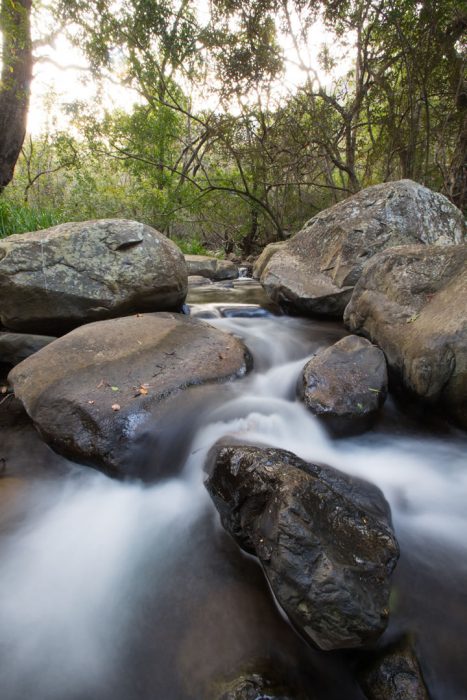Protected areas and restitution
Protected areas on state, communal and private land play an important role in safeguarding high priority biodiversity areas and ecosystems in the Olifants River Catchment. Significantly, the majority of nature reserves in Limpopo and Mpumalanga are under land claim or have already been restituted to communities. These will all be governed through some form of co-management between the provincial conservation agencies and claimant communities.
However there is not much experience of co-management (especially of institutional arrangements and beneficiation models in smaller reserves) in South Africa despite longer standing regional and international practice. The lack of experience and capacity in this field poses considerable challenges and even threats to protected areas and livelihoods.
The Legalameetse Nature Reserve (LNR), lying in the biologically-diverse Wolkberg Mountains and headwaters of the Selati River, is one such reserve. However lack of capacity together with institutional dynamics and tensions have challenged successful co-management arrangements thus far despite its provincial priority status. Experiences from Legalameetse offer invaluable lessons for other reserves for successful co-management.
Brief History of Land Claimants of LNR
 Communities that were forcibly removed from Legalameetse during the apartheid era, claimed land successfully in 2005 and started work on a co-management together with Limpopo Economic Development, Environment and Tourism. There are six communities with land claims in the LNR:
Communities that were forcibly removed from Legalameetse during the apartheid era, claimed land successfully in 2005 and started work on a co-management together with Limpopo Economic Development, Environment and Tourism. There are six communities with land claims in the LNR:
- Madutula (Mangena),
- Mamashiana,
- Paris,
- Cyprus,
- Balloon and
- Madeira.
LEDET (including the former-parastatal Limpopo Tourism Authority (LTA)) is responsible for the reserve. LEDET is the ‘Management Authority’ responsible for overseeing conservation and biodiversity management, while LTA is responsible for tourism management in the Reserve. The land owners are negotiating involvement in beneficiation and development of the reserve whilst also wanting to better understand reserve management and ecological significance.
An area of biodiversity & water significance
 Legalameetse Nature Reserve (LNR) is a formally proclaimed nature reserve in Limpopo province, and covers a total area of about 18 700 ha. The LNR conserves biodiversity of significant value including an exceptionally diverse flora forming part of the Wolkberg and Sekhukhuneland Centres of Plant Endemism. This diversity is largely a result of the high diversity of vegetation types (and biomes) present within the reserve, which includes Northern Escarpment Quartzite Sourveld, Wolkberg Dolomite Grassland, Poung Dolomite Mountain Bushveld, Tzaneen Sour Bushveld, and Northern Mistbelt Forest.
Legalameetse Nature Reserve (LNR) is a formally proclaimed nature reserve in Limpopo province, and covers a total area of about 18 700 ha. The LNR conserves biodiversity of significant value including an exceptionally diverse flora forming part of the Wolkberg and Sekhukhuneland Centres of Plant Endemism. This diversity is largely a result of the high diversity of vegetation types (and biomes) present within the reserve, which includes Northern Escarpment Quartzite Sourveld, Wolkberg Dolomite Grassland, Poung Dolomite Mountain Bushveld, Tzaneen Sour Bushveld, and Northern Mistbelt Forest.
The LNR flora includes well over 1 700 species, with at least 36 plant species of conservation concern, including endemic and rare species. The reserve is also noteworthy for its high diversity of invertebrate species, especially butterflies – nearly 40% of all butterfly species found in South Africa are found here. The LNR further forms part of the Wolkberg Forest Belt, an internationally recognised Important Bird & Biodiversity Area under Birdlife International, supporting several rare bird species.
The LNR forms part of the Olifants Catchment and is an important component of the Wolkberg Node of the nationally recognised Strategic Water Source Areas. Eight perennial rivers and streams, including the Selati, Makhutšwe and the Ngwabitsi Rivers, originate within the reserve. The abundant water sources arising in the reserve are all of high quality, supporting both communities and large agricultural enterprises downstream.
Special species:
- Birds: Cape Parrot, Orange Ground Thrush, Knysna Loerie
- Plants: Modjadji cycad, Sekhukhuni Bushman’s Tea, Pearsonia callistoma, Barleria dolomiticola
- Butterflies: Wolkberg Widow, Wolkberg Zulu, Juanita’s Hairtail, Lotana blue


